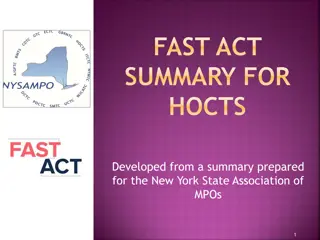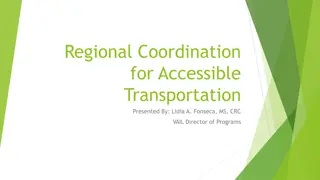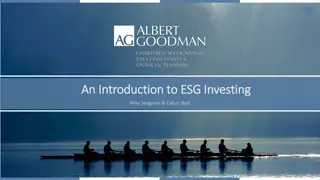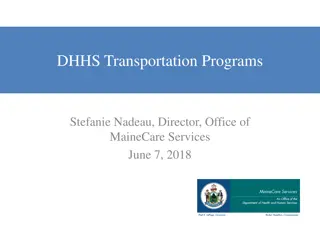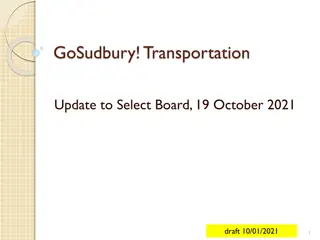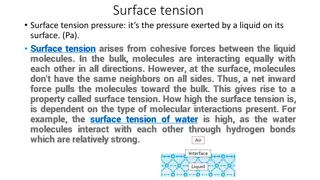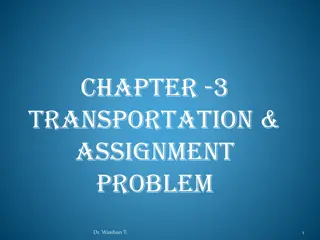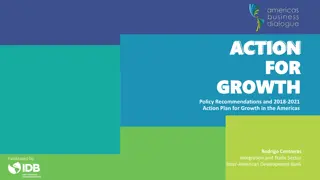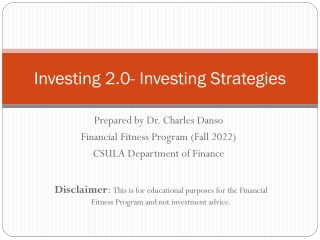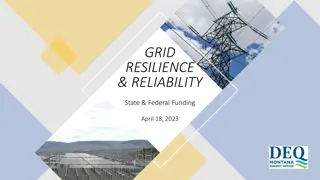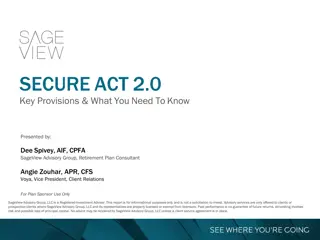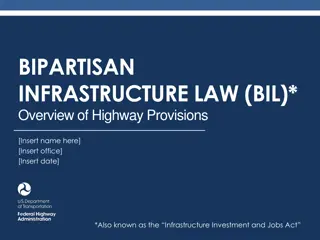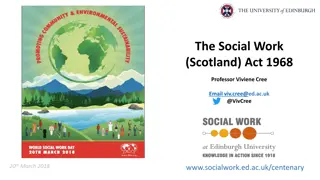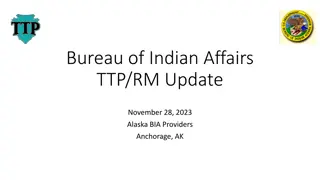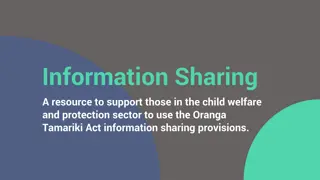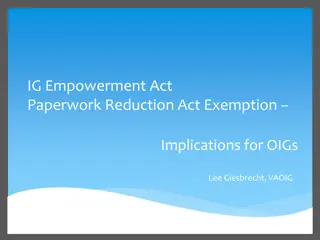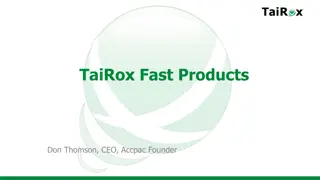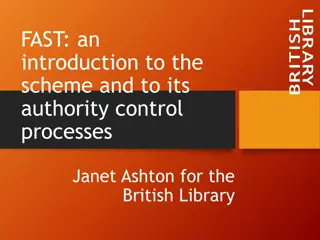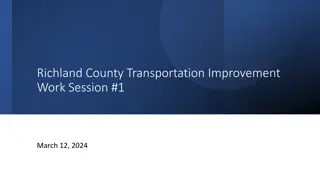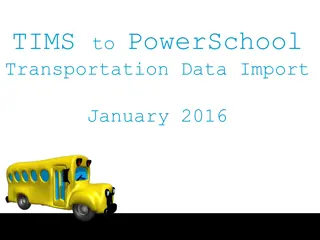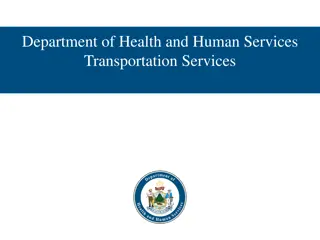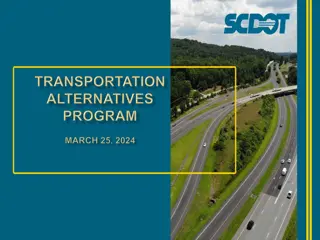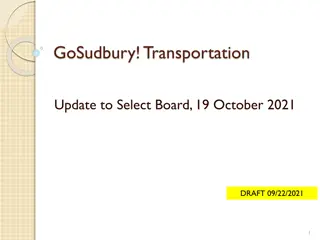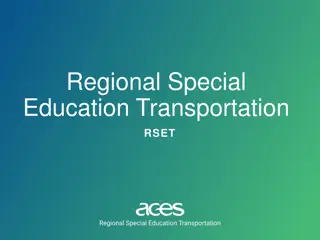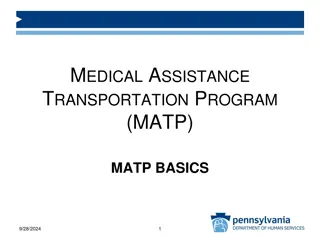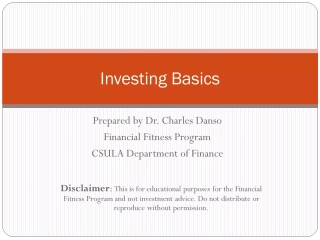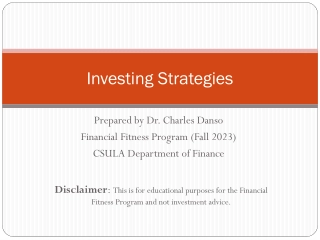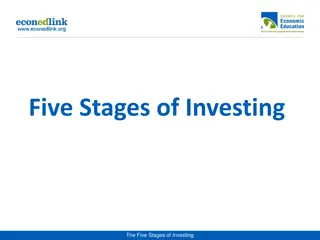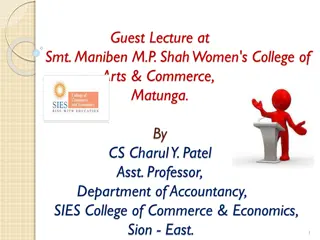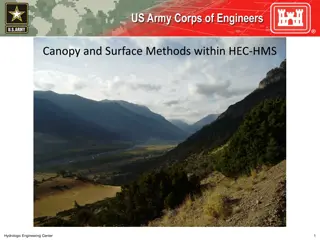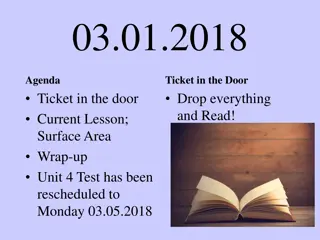Key Provisions of the FAST Act: Investing in America's Surface Transportation
The Fixing America's Surface Transportation (FAST) Act, signed into law by President Obama in 2015, provides $305 billion in funding over five years for various infrastructure programs. It aims to ensure funding certainty for infrastructure planning and investment, with a focus on highways and transportation safety. The Act introduces new funding formulas, expands freight networks, and emphasizes project delivery acceleration. Additionally, it includes programs for nationally significant projects and tribal self-governance options, promoting cooperative bipartisan efforts in the transportation sector.
Download Presentation

Please find below an Image/Link to download the presentation.
The content on the website is provided AS IS for your information and personal use only. It may not be sold, licensed, or shared on other websites without obtaining consent from the author. Download presentation by click this link. If you encounter any issues during the download, it is possible that the publisher has removed the file from their server.
E N D
Presentation Transcript
P.L. 114-94 Fixing America s Surface Transportation (FAST) Act Key Highway Provisions
2 FAST Act Signed by President Obama on December 4, 2015 First long-term authorization act in a decade Result of bipartisan cooperation and compromise Provides 5 years of funding certainty for infrastructure planning and investment Authorizes $305 B (all modes) over FY 2016-2020 $70 B in transfers to keep the Highway Trust Fund solvent; fully paid for (offset) by unrelated savings
3 $305 B (all modes) over FY2016-2020 Program 5-Year Funding (billions) Federal Highway Administration $ 226.3 Federal Transit Administration 61.1 Federal Motor Carrier Safety Administration 3.2 Pipeline and Hazardous Materials Administration 0.4 National Highway Traffic Safety Administration 4.7 Federal Railroad Administration 10.3 Total 305.0
4 Key Highway Facts $226.3 B for highways over five years (FY 2016-2020) $225.2 B in contract authority $1.1 B from the General Fund Builds on the program structure and reforms of MAP-21 Continued focus on accelerating project delivery Adds a new freight formula and expands freight network Adds a new discretionary program for nationally significant freight and highway projects Provides a new tribal self-governance option
5 Highway contract authority grows each year Highway Authorizations from Trust Fund (billions) $50 $47.1 $46.0 $45.0 $44.0 $43.1 $41.0 $40 $30 $20 $10 $0 FY 2015 FY 2016 FY 2017 FY 2018 FY 2019 FY 2020
6 APPORTIONED PROGRAMS
7 Growth Varies by Program Program Avg. Annual Funding (millions) Change from FY 2015 $ 23,280 +6.3% National Highway Performance Program 11,654 +15.6 Surface Transportation Block Grant Program Transportation Alternatives Set-aside [760] +3.3 Recreational Trails Program Set-aside Surface Transportation Block Grant Program (net of TA & Rec Trails) Congestion Mitigation & Air Quality Improvement [84] 0.0 +7.3 [10,809] 2,405 +6.1 2,317 +5.7 Highway Safety Improvement Program 235 +6.8 Railway-Highway Crossings Program 343 +9.5 Metropolitan Planning 1,249 NEW +100.0 National Highway Freight Program
8 92% of Highway Funds Are Apportioned National Highway Freight Program Grade Crossings CMAQ Rec Trails HSIP Transportation Alternatives National Highway Performance Program Surface Transportation Block Grant (STBG) Program $207.4 B over 5 years Metro Planning
9 Changes to NHPP and STP Prgm Changes NHPP TIFIA costs and V2I communication equipment now eligible Bridge resurfacing/preservation/reconstruction on non-NHS Federal- aid highways now eligible STP Renamed: Surface Transportation Block Grant Program (STBG) Eligibilities restated with none eliminated; new eligibilities for TIFIA costs, State P3 office, V2I communication equipment In border States, up to 5% for infrastructure projects eligible under the SAFETEA-LU border program More suballocation: +1%/year up to 55% (vs. 50% today) Set-asides for Transportation Alternatives and Recreational Trails (see next slide)
10 Changes to TAP, CMAQ, and HSIP Prgm TAP Changes Same program, but no longer called TAP; no name specified All funds set aside from STBG (vs. from all formula programs today) Nonprofits responsible for local transportation safety programs may be project sponsors CMAQ Installation of V2I communication equipment eligible Port-related equipment & vehicles eligible under PM2.5 set-aside Reduction of PM2.5 set-aside for low population density States (under certain conditions) HSIP Only listed project types eligible mostly infrastructure-related Adds eligibility for V2I communication equipment and certain pedestrian safety improvements State need not collect certain data on unpaved roads (but can t use HSIP funds on those roads until it collects the data)
11 FREIGHT
12 National Highway Freight Program | NEW $1.2 B / year (average), apportioned to States by formula Eligible activities include construction, operational improvements, freight planning and performance measures Highway focus, but 10% for rail/port/intermodal projects States required to have freight plans to obligate NHFP funds (beginning December 4, 2017) Federal share is determined under 23 USC 120 Repeals special Federal share for freight projects
13 FASTLANE Grants | NEW (Nationally Significant Freight & Hwy. Projects) $900 M/year (average) for competitive grants or TIFIA loans for projects $100 M (reduced for States w/ small programs) Eligible activities: Highway freight projects on National Highway Freight Network NHS highway/bridge projects, projects in National Scenic Areas Freight rail/intermodal/port projects ( $500 M over 5-year period) Rail-highway grade crossing or grade separation projects States, large MPOs, Tribes, localities, and FLMAs may apply OST selects projects; Congress has 60 days to disapprove Set-asides for rural areas and projects below cost threshold
14 Other Freight Provisions Freight policy goals and multi-modal national freight strategic plan State freight plans (required) & advisory committees (encouraged) National multimodal freight network National Highway Freight Network, to include: Primary Highway Freight System (PHFS); initially 41K miles Critical rural freight corridors identified by States Critical urban freight corridors with State-MPO consultation Portions of Interstate System not included in the PHFS Primary Highway Freight System re-designated every 5 years (with up to 3% growth)
15 FEDERAL LANDS & TRIBAL
16 Federal Lands & Tribal Programs Program Average Annual Funding (millions) Change from FY 2015 Federal Lands Transportation Program National Park Service Fish & Wildlife Service Forest Service | NEW Remainder (competitive) $ 355 [284] [30] [17] [24] 260 +18.3% Federal Lands Access Program +4.0 Tribal Transportation Program Nationally Significant Federal Lands and Tribal Projects (General Fund) | NEW 485 +7.8 100 +100
17 Federal/Tribal Lands Program Changes Tribal Transportation Program Less funding for BIA/FHWA oversight; more funding for tribal bridges New annual reporting by Tribes Federal Lands Transportation Program New partners: Bureau of Reclamation and other independent agencies Dedicated funds for Park Service, Fish & Wildlife, Forest Service | NEW Emergency Relief Clarified eligibility for debris removal on ERFO-eligible facilities Access program facilities no longer eligible for 100% Federal share Nationally Significant Federal Lands & Tribal Projects | NEW Discretionary grants for large Federal and tribal lands projects All funds subject to appropriation
18 Tribal Self-Governance Program | NEW More responsibility and flexibility for participating Tribes Tribe assumes responsibility for use of highway/transit funding Tribe receives significant flexibility in use of funds Funding must be used for the authorized purpose To participate, Tribe must demonstrate three FYs of financial stability and capability in financial and program management DOT and Tribal relationship/terms specified in multi-year compact Under annual agreement, Tribe plans, consolidates, and receives Full Tribal share funding Tribal transit formula funding Discretionary/competitive grant funding administered by DOT DOT to initiate negotiated rule within 90 days; NPRM in 21 months
19 RESEARCH, DEVELOPMENT, TECHNOLOGY & EDUCATION
20 RDT&E Funding Program Avg. Annual Funding (millions) $ 125.0* Change from FY 2015 +8.7% Highway R&D Alternative Funding Demonstration Grants Future Interstate Study Performance Management Data Support Technology & Innovation Deployment Program Accelerated Implementation of Pavement Tech. [19.0] [1.0] [up to 10.0] 67.4* [12.0] +7.8 Training & Education 24.0 0.0 Intelligent Transportation Systems Research 100.0* 0.0 University Transportation Centers 75.5 +4.1 Bureau of Transportation Statistics 26.0 0.0 [$60.0]* *Advanced Transportation & Congestion Management Technologies Deployment Grants (to be funded from Highway R&D, TIDP, & ITS Research) Flexible funding in HRD, TIDP, and ITS programs 200.0 -24.7
21 PLANNING, PERFORMANCE & PROJECT DELIVERY
22 Planning & Performance More consultation and participation Enables participation by public ports, private transportation providers Encourages MPO consultation with other types of planning activities Changes to selection criteria for MPO officials Other changes to planning and performance TIPs/STIPs/long-range plans must include facilities that support intercity transportation New planning considerations: resiliency/reliability, stormwater mitigation, and enhancement of travel/tourism Long-range State plan must describe perf. measures and targets Consequence (reporting) for State making insufficient progress toward freight targets
23 Accelerating Project Delivery A major theme of the FAST Act, with 18 separate provisions in the highway title alone. The Act Adds New Flexibilities Section 4(f) exemption for some bridges Authorizes taking of nesting swallows in at-risk bridges Refines Existing Provisions Narrows concurrence requirement for PEL Pilot for substitution of State law for NEPA
24 Accelerating Project Delivery, cont d Adds to Procedural Requirements Requires a schedule, a checklist, and response to project initiation Adds some new specific time frames for notices and reviews Builds on Existing Activities Requires permitting dashboard (but covers all EISs & EAs) DOT to maximize use of authority to delegate project oversight to States on both a project and programmatic basis
25 OTHER PROGRAMS & PROVISIONS
26 TIFIA and Ferry Boat Programs Changes to TIFIA (beyond 71% funding cut) New eligibilities for transit-oriented development (TOD), capitalizing rural projects fund in a SIB Lower min. cost ($10 M) for local govt. applicants and for TOD TIFIA now eligible under NHPP, STBG, Nationally Significant Freight and Highway Projects No more requirement to redistribute uncommitted TIFIA funds Reserves at least $2 M to be used in lieu of fee payment by applicants for loans for projects costing less than $75 M Changes to ferry program Formula now gives more weight to number of ferry passengers After 4 years, FHWA withdraws unobligated Ferry program funds (and distributes them to other eligible recipients)
27 Tolling/HOV Tolling Technical clean up of statutory language Requires same treatment on certain toll facilities for over-the-road buses and transit buses Must consult MPO on toll placement/amount for HOT lanes on Interstate facilities within metropolitan planning area ISRRPP Expiration timeframe for provisional approvals: Those in place before FAST Act expire 1 year after enactment of FAST Act (with possible 1-year extension) New ones (post-FAST) expire after 3 years (w/possible 1 yr. extension) Allows waiver of sanctions for degraded HOV operation under certain conditions
28 Highway Design On NHS, design "shall consider" (previously may take into account") constructed/natural environment environ., scenic, aesthetic, historic, community, & preservation impacts access for other modes cost savings via flexibility in current design guidance/regulations | NEW DOT to consider AASHTO Highway Safety Manual, NACTO Urban Street Design Guide Encouragement for States/MPOs to adopt standards for Fed. projects that accommodate motorized and non-motorized users Locality may use different roadway publication than State (with State approval) in certain circumstances
29 Other Provisions Drop slide? Specifically allows multiple similar bridge projects to be handled ( bundled ) into a single project DOT to designate national electric vehicle charging and hydrogen, natural gas, and propane fueling corridors Encouragement of vegetation management practices that improve habitat and forage for pollinators State may opt for Federal share <100% for Appalachian Development Highway System (ADHS) projects
Office of Policy & Governmental Affairs August 2016


